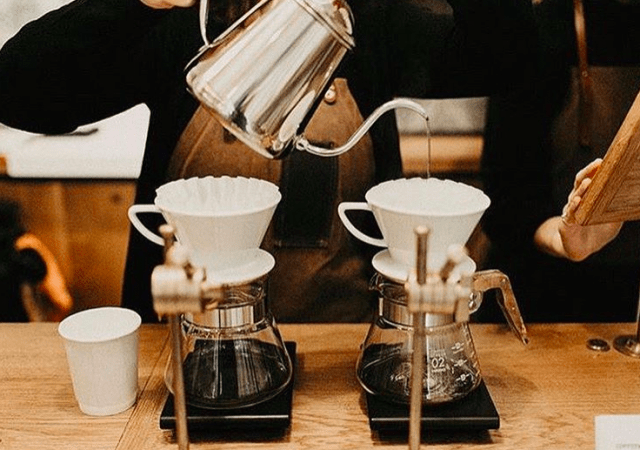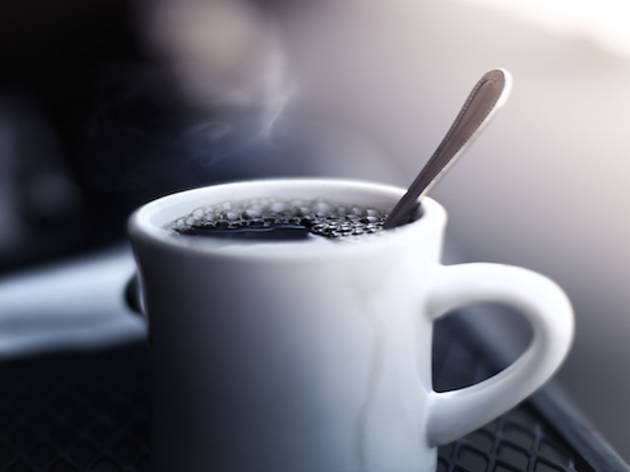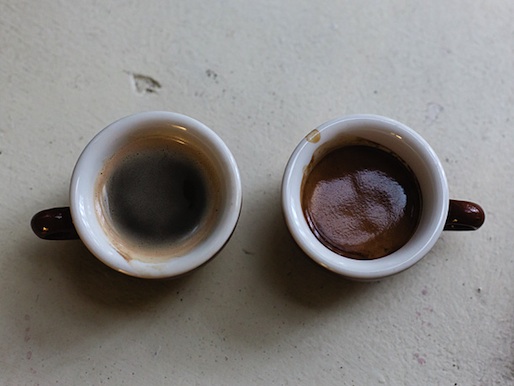Creating a cup of coffee with the right taste _ mastering extraction is tantamount to mastering the heart method of brewing coffee
Professional coffee knowledge exchange more coffee bean information please follow the coffee workshop (Wechat official account cafe_style)
"learning to drink coffee is not only to explore the outside, to distinguish the differences between coffee, but also to know yourself inward. "
Create a cup of coffee with the right taste
In the stage of planting and fruit refinement, the quality of the coffee bean itself has been cast, and at all subsequent stages, whether roasting or brewing, it is impossible to violate the nature of coffee. Does this mean that as long as the beans are good in nature, you don't have to care about baking and cooking? Wrong! Because even if baking does not change the essence, it can change the results that drinkers feel. We can only say that choosing good beans is the starting point for good coffee, but it is only an admission ticket, and there is no guarantee that good beans will eventually turn into a good cup of coffee.
Create the conditions for good coffee
I think there are three basic conditions for creating a cup of coffee with good taste: mind, concept and craftsmanship. "heartwarming" refers to what you want this cup of coffee to show. I often tell students that it is important to make a cup of coffee with ideas. Today we are not passively waiting for the taste to come to us, but we take the initiative to create the flavor we want. I often encourage students not to learn only one method, but to dabble in a wide range of methods. Let me give you an example. The world of hand-brewing coffee costs a lot of yuan, and there are all kinds of cooking methods. Suppose we roughly estimate that there are 300 methods. I don't think any of these methods is absolutely the most powerful. We just pick out the ones that best suit our tastes and ingredients from these 300 methods.
"craftsmanship" refers to the technical conditions, when you want to create a cup of coffee for yourself, you can't just listen to the teacher and read a book. Just like you know all kinds of kung fu schools, you speak kung fu well, but you don't practice your horse step in a down-to-earth way, can it come in handy when you encounter the actual situation? We must emphasize that all courses and books only provide methods and tools, and you are the one who uses the tools. Only when you overcome the technical hurdle can you create a cup of coffee with the right taste in your heart and hand.
"concept" refers to whether you have a comprehensive understanding of brewing coffee. I don't mean that you have to make a lot of painstaking and in-depth study of coffee in order to make good coffee. I want to emphasize that you need to have a more comprehensive understanding of what you are doing. This understanding includes an understanding of the coffee beans you are going to brew today, as well as the tools you use, and finally you have an understanding of the causes that will occur when brewing coffee. Understanding the ingredients themselves is one of the qualities necessary to be a good barista, ──. Where do you know these beans come from (knowledge of origin)? What kind of flavor (appreciation and taste)? And where do you want to take it (flavor show)? We should first respect the personality of coffee beans, and then show the taste we want from them.
Brewing coffee vs extraction coffee
When it comes to brewing coffee, you may have heard a strange word called "extracted coffee", which is mentioned in the second chapter, that is, the whole process of dissolving the substance out of coffee powder by water. Sometimes if you eavesdrop on the conversation between baristas, you will hear, "Oh, your cup of coffee is overextracted!" "or" this cup of coffee feels like there is not enough extraction. "because all the cooking methods and adjustment rules are based on" extraction ".
Brewing is a kind of behavior, and extraction is the principle behind this behavior. why professional baristas talk about extraction is because we change the results through the application of principles. Brewing is just the behavior you see outside. It is worthless to say that it is worthless. As long as you can master the principle of extraction, you will have mastered the secret method of making coffee.
I used to use the metaphor of "channel" to explain the extraction of coffee. Take hand-brewed coffee as an example. When you pour water into the powder cup of coffee powder, the channel opens, and when the last drop of coffee liquid leaves the coffee powder, the channel is closed. In the opening and closing of the channel, how to strike a balance and how to release more of the material we want? How to release less substances that will lead to negative flavor is a subject that all coffee workers in the world are committed to study.
Extraction is a method of separating substances by using different solubility of substances. If coffee beans are regarded as 100% intact, the extraction rate can be calculated as long as the amount of substances separated from coffee beans in the water is calculated. The extraction rate is a convenient method. By calculating the extraction rate, we can figure out what percentage of the substance in the coffee is released into the water during the period when the channel is opened.
However, the extraction rate can only show how many substances have entered the water, and it cannot tell us the proportion of good substances and bad substances in the water. Even so, using the concept of extraction rate to brew coffee is a major breakthrough in the long history of human coffee brewing, because most of the time people brew coffee "by feeling", that is to say, brewing coffee is an artistic behavior. when we discuss coffee from the perspective of extraction rate, we have crossed the boundary of feeling and entered the field of empirical science.

Is there an ideal extraction in the world?
Is there an ideal extraction in the world? Yes! Good coffee is the ideal extract, of course, bad coffee must be the ideal extract. Don't take this as nonsense, think about it and you'll see what it really means: we don't always release the flavor we want when we extract coffee, and more often, the reason why we ruin a cup of coffee is that we accidentally release the evil flavor hidden in the coffee beans.
First man in history to quantify coffee flavor
The Enlightenment took place in the 17th and 18th centuries. Because of the scientific revolution, people began to pursue rationality and knowledge and stressed the importance of positivism. However, the Enlightenment of coffee did not appear until the twentieth century. Before brewing began, I felt that I must introduce this important hero who combined coffee with science. He was the first man in history to quantify coffee flavor-Dr. Ernest Eral Lockhart.
Dr. Lockhart is arguably the father of coffee extraction theory, and almost all current theories about coffee extraction are based on Dr. Lockhart's research. Dr. Lockhart tells us scientifically that coffee doesn't taste good until you drink it. You can know in advance whether this cup of coffee will taste good or not from the relationship between extraction rate and concentration. And you can also use these two data to figure out how to improve coffee.
Dr. Lockhart, principal investigator of the American Coffee Brewing Association, compiled his research into a simple chart that all coffee lovers who want to make good coffee can use to correct their brewing. The chart is called the Coffee Brewing Control Chart.
According to his research, coffee beans can be separated into about 28% water-soluble organic matter and 72% water-insoluble cellulose, and coffee extraction is the process of separating the two. Among the 28% organic substances that can be dissolved in water, they can also be subdivided into substances with high hydrophilicity and easy water solubility, and substances with low hydrophilicity and difficult water solubility.
In the 1950s, Lockhart's research team extensively collected coffee preferences across the United States, collecting nearly 10,000 pieces of data over a period of several years, setting the same coffee at different "Concentration" and "Yield", and then asking people to try it and report which cup they liked.
For many friends who have just come into contact with brewed coffee, it is easy to confuse extraction rate with concentration, but in fact the two are two different concepts. The extraction rate, as just mentioned, refers to the proportion of the original beans carried out by the solvent of water in the coffee beans themselves. For example, if 20 grams of coffee powder is used, the extraction rate is 20%, 20×20%=4, which means that 4 grams of substances are transferred from the beans to the coffee. The concentration is based on the ratio of these extracted substances to the final brewed coffee solution.
Drip coffee (hand brewed) usually has a strength of between 1 and 2 percent, and espresso coffee (espresso coffee) has a strength of more than 7 percent. Continuing with the example just given, when 20 grams of coffee powder is used to dissolve 4 grams of substance into the coffee, and the final coffee liquid is found to weigh 250 grams, it means 4÷250=0.016=1.6%, and the coffee concentration is 1.6%.
The Specialty Coffee Association (SCA) adopted Dr. Lockhart's brewing table, setting the ideal extraction rate of drip coffee at 18 - 22% and the concentration at 1.2 - 1.45%, and called this system the "Gold Cup Standard" as an important basis for promoting coffee brewing to the public.
Use your senses to get your coffee into the strike zone
The Gold Cup Coffee Guidelines design a quadrant table that lists extraction rates on the X axis and concentrations on the Y axis. The X axis divides into low extraction (<18%), high extraction (>22%), and intermediate ideal values. The Y-axis is divided into low concentrations (<1.2%), high concentrations (>1.45%), and intermediate ideal values. This forms a nine-square grid.
Nine possible ways to brew coffee range from "under-extraction,""over-extraction,""ideal extraction" multiplied by "too low concentration,""too high concentration," and "ideal concentration." Don't you think this chart looks like a baseball grid? If we can brew a cup of coffee into the ideal concentration and ideal extraction rate intersection zone, it means that you brewed coffee into the strike zone. The difference between a professional barista and a novice brewer is the same as between a professional pitcher and a teenager who has just lost a baseball. If you are not familiar with losing the ball, it is easy to produce "wild shots". We also say that coffee that does not enter the strike zone is "boiled".
However, the most different thing from losing baseball is that the nine-square grid of coffee is abstract and must be shaped through your taste and smell. Although Dr. Hart's data can provide guidance, coffee still has to return to taste. We need to use our senses to make your coffee into the strike zone. If you want to brew coffee into the strike zone, learn to drink it first!
In a discussion of strength, a simple example is espresso coffee. A barista uses the same coffee beans and uses the same coffee machine to make two cups of the same espresso. At this time, the extraction rate of the two cups of coffee is close. At this time, one of them is diluted with extra water, and there will be two cups of coffee with different strengths.
Low-strength coffee is like constantly adding water to espresso, and the end result is that you can hardly taste the coffee itself, you will feel like drinking coffee-flavored water, baristas often describe such coffee as "empty" or "watery."
Strong coffee is like my experience with espresso for the first time: no flavor, probably only strong bitterness or acid. Too high a concentration of coffee will make us unable to distinguish flavor, for example, you can try to make coffee in the hand, take a spoon to retain the earliest coffee liquid, this high concentration of coffee will usually make people feel that the flavor is suppressed feeling, the magic is that when you dilute with water, some flavors will suddenly become obvious.
Temperature and time are two key factors affecting coffee extraction rate. High temperature and long time increase extraction rate, otherwise decrease extraction rate. All substances that can be dissolved by water, whether we like them or dislike them, begin to separate out at the same time that water comes into contact with powder, and end when water separates from powder. Some substances make us feel sweet, some make us experience the mellow body of coffee, and some make us feel bitter.
Coffee with a low extraction rate tastes sharp, sometimes loses its finish (flavor in the front but suddenly becomes empty in the back), and sometimes tastes salty in under-extracted espresso. In contrast, coffee with a high extraction rate may leave you feeling intensely bitter, and more often you will feel dry in your mouth and want to drink.
Usually, coffee is often a compound problem, so we need to take into account both extraction rate and concentration. According to the gold cup theory, the most common coffee is probably the following four:
1. The bitterness was so intense that it even felt like his throat was locked.
Drink this kind of coffee feel very burden, can not drink the whole cup, belong to the coffee with high concentration and high extraction rate. If the brewed coffee belongs to this area, you can try to maintain the ratio of coffee powder to water, reduce the brewing temperature and shorten the brewing time, or observe whether the coffee is ground too fine.
two。 Slightly bitter, the flavor is not obvious, feel the lack of later flavor and end rhyme, after drinking, I feel my mouth is a little dry.
It belongs to high extraction rate and low concentration, which may be caused by unstable hand flushing flow or skew when filling coffee pressed powder. The way to correct it is to reduce the ratio of coffee to water, lower the water temperature or shorten the brewing time at the same time.
3. The performance of the acid is too prominent, but the taste is not enough, there is no other taste convergence after the sour taste.
It belongs to low extraction rate and high concentration, which usually occurs when the water temperature is too low. You can try to increase the water temperature and lengthen the cooking time, and increase the ratio of coffee powder to water at the same time.
4. Although there is no strong acid, but in addition to the sour taste does not seem to drink anything else, at the same time feel the water.
It belongs to low extraction rate and low concentration, which increases the water temperature or lengthens the cooking time as in the case of 3, but maintains the ratio of coffee powder to water.
Source: "Taste Coffee: follow the cup tester to get to know the 36 flavors of coffee and find the best coffee."
Author: Wang Renjie
END
Important Notice :
前街咖啡 FrontStreet Coffee has moved to new addredd:
FrontStreet Coffee Address: 315,Donghua East Road,GuangZhou
Tel:020 38364473
- Prev

After drinking coffee, how long can caffeine be metabolized in the body?
Professional Coffee knowledge Exchange more information about coffee beans Please follow the coffee workshop (official Wechat account cafe_style) at 2pm, you are so sleepy that you can hardly open your eyes. At this point, it seems like a difficult choice whether you want to fight a tired nap or have a cup of coffee to cheer yourself up. Let's take a brief look at how coffee keeps you awake. Coffee contains
- Next

One cup of good coffee is enough! Coffee common sense that you may not know!
Professional coffee knowledge exchange more coffee bean information Please follow the coffee workshop (Wechat official account cafe_style) Coffee has become more and more popular in China in recent years. The charm of coffee lies in that it is full-bodied, mellow and relaxing in its proper bitterness. Today, the editor is here to share some common sense of coffee that he may not know, hoping to provide some help to friends who love coffee.
Related
- Beginners will see the "Coffee pull flower" guide!
- What is the difference between ice blog purified milk and ordinary milk coffee?
- Why is the Philippines the largest producer of crops in Liberia?
- For coffee extraction, should the fine powder be retained?
- How does extracted espresso fill pressed powder? How much strength does it take to press the powder?
- How to make jasmine cold extract coffee? Is the jasmine + latte good?
- Will this little toy really make the coffee taste better? How does Lily Drip affect coffee extraction?
- Will the action of slapping the filter cup also affect coffee extraction?
- What's the difference between powder-to-water ratio and powder-to-liquid ratio?
- What is the Ethiopian local species? What does it have to do with Heirloom native species?

